-
1300 994 890Property Management1300 832 373Consulting & Certification
Fire Safety for Specialist Disability Accommodation
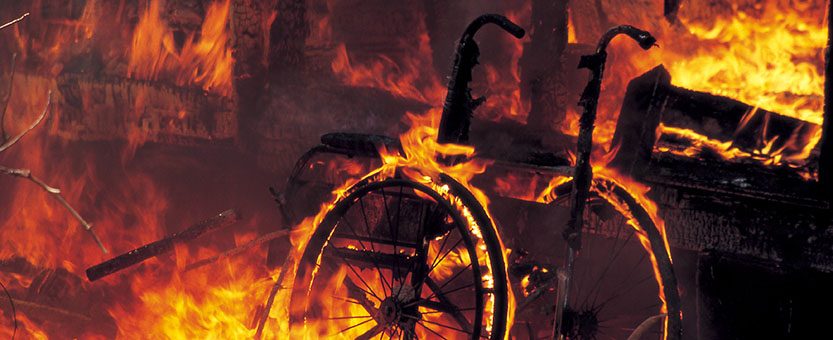
There will be fatalities! It’s not if, but when!
Specialist Disability Accommodation (SDA) first rolled out in 2013 and is aimed at designing houses for persons with ‘Extreme Functional Impairment or Very High Support Needs’. These are identified under the National Disability Insurance Scheme (SDA) Rules 2016 as an impairment resulting in an extremely reduced functional capacity to undertake in one or more activities of mobility, self-care or self-management and has a very high need for person to person support.
The result is that particular attention will need to be paid to design suitability for occupants of these dwellings in particular, life safety features such as fire alert/suppression systems, but is our current building legislative system set up to protect this new market and its residents?
Dangers of house fires
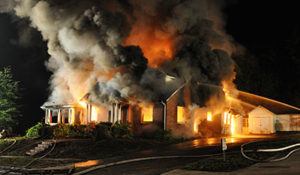
The number of avoidable house fires in Victoria is increasing. Home fires are on the rise due to small mistakes. There are hidden horrors lurking in every Victorian home. They are disguised in many forms, from the humble hairdryer, to the heater, and even your mobile phone. In 2015 there were 3211 preventable house fires in Victoria, up from 3170 in 2014, which included 9 deaths in preventable house fires.
There were 17 accidental fire deaths and more than 4,070 home fires in NSW in 2015 making it a deadly year for home fires.
According to the Australian Bureau of Statistics, fires tend to be more prevalent through the colder months of the year: approximately one third of house fires in NSW occur between June and August of each year. Although the number of deaths from house fires is relatively small (representing 1.5% of accidental deaths and 0.06% of all deaths nationally in 1998), all accidental deaths are generally regarded as preventable.
Accordingly, to improve fire safety the regulations brought into the Building Code of Australia (BCA) by the States has made the installation of smoke alarms in new homes mandatory. Victoria introduced a smoke alarm requirement into the BCA in June 1993, and most other States introduced a similar requirement in November 1994. A national requirement was introduced into the BCA in 1996. Victoria also introduced a retrospective regulation in February 1997 that existing homes built before August 1997 must be equipped with smoke alarms.
Causes of house fires
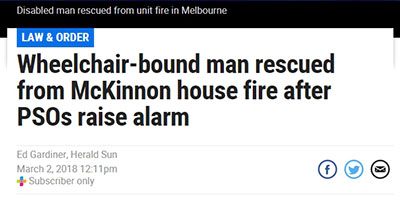 Although the causes vary – from dinner left to burn on the stove to overcharged laptops or clothing left to dry too close to a heater – all fires had one thing in common: a small mistake had serious consequences.
Although the causes vary – from dinner left to burn on the stove to overcharged laptops or clothing left to dry too close to a heater – all fires had one thing in common: a small mistake had serious consequences.
In 2015, 41 per cent of preventable house fires started in the kitchen, 9 per cent in the lounge room and 7 per cent in the bedroom. The most common causes of fire were unattended cooking (18%), heating (13%), smoking and faulty electrical appliances. There were 3,211 preventable house fires in Victoria last year, but there would be many more close calls which go unreported.
Information collected by the NSW Fire Brigade shows that fires identified as started by unattended heat sources caused 23% of accidental house fires in NSW in 1998 and increased by 86% between 1987 and 1998.
The biggest increases belonged to the suspicious (136%) and incendiary (310%) categories. These fires, which may be deliberately set, usually cause more damage than do fires that are ignited accidentally.
Whatever the main cause, many fires are triggered by some failure or malfunction in an appliance or a piece of equipment, whether attended or not. In 1987, 73% of all house fires had equipment misuse or malfunction as the main contributing factor. This proportion had dropped to 62% in 1998.
In the cooking equipment category (30% increase between 1987 and 1998), fires from ovens rose by 79% from 138 fires in 1987 to 247 fires in 1998. While not a major cause, fires from portable cooking and warming units also rose sharply by 119%, from 27 fires in 1987 to 59 fires in 1998 (Abs.gov.au, 2018).
NSW Fire Brigade Survey
The NSW Fire Brigade designed a questionnaire to be completed by experienced NSWFB firefighters. The survey was completed by 85 participants with the focus on utilising fire fighters who had attended a large number of house fires over a 10-20 year career or fire fighters who had been exposed to house fires over a 20+ year career.
The strength of this report lies in the information provided through statistics gathered from a widely experienced group of fire fighters from all over NSW. Over 96% of respondents had over 10 years experience and 48% of those had in excess of 20 years service. An estimated 10,000 house fires had been attended by the respondents.
From the questionnaire’s findings, over 75% of firefighters believed that the risks to firefighters had increased because of changes in the construction, design layout and contents of houses. Almost 50% believed that modern house fires were taking longer to bring under control due to the fuel loads within houses and the type of construction. Another important finding was that over 80% of respondents believed that the structural stability was lower in modern style houses during fire incidents.
The last two questions required the respondents to recall house fires they had attended and the responses reinforced the anecdotal evidence that had been observed over the past few years. The issues such as lightweight construction, air conditioning ducting, open plan design, lack of compartmentation, and household furnishings all ranked highly in having a significant impact on fire spread and structural integrity.
Other specific issues raised by the firefighters included I-beams, expanded polystyrene (EPS) cladding, and heating ducts.
In addition, 61% of senior NSWFB firefighters interviewed as part of this study believed that modern security measures such as deadlocks and security screens directly contributed to injuries and fatalities at house fires (Proceedings.com.au, 2018).
Case Studies
The following case studies look at three separate fires in accommodation for persons with disability, backpackers and aged care.
The first was a fire in 1996 at Kew Cottages, accommodation for the intellectually impaired, which led to improvements of fire safety for accommodation and better care for vulnerable members of the community.
The second case study is the Childers Palace Backpackers fire in 2000. Whilst this fire was deliberately lit, and the building complied with current building codes and standards at the time, the continued development of the building over the years, without a requirement to revisit suitability of existing safety features showed that complying with legislative requirements at the time of construction is not necessarily fit for purpose over the lifetime of a building.
The third case study is Quakers Hill Nursing Home fire which contained a large number of residents requiring assistance to evacuate. Again, inadequate fire safety features were either the direct cause or attributed to the death of 11 residents and illustrates how improved safety standards, such as sprinklers can save lives.
Kew Cottages Fire
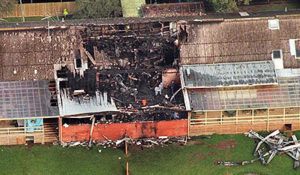
The fire at Kew led to safer accommodation and care for vulnerable members of the community with Victorian Government making fire sprinklers mandatory within residential care buildings and requiring retrofit within those constructed before August 1997.
Childers Palace Backpackers Fire
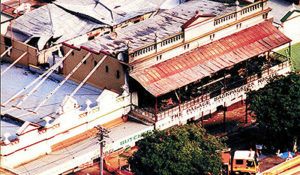
On 23 June 2000 a fire broke out within the building that claimed the lives of 15 young people from Australia and other countries. From the accounts of survivors, it appeared that fire alarm systems were not operating. People who were familiar with the hostel said that there was only one exit door leading outside from the top floor at the rear of the building. However, it is understood that the hostel had complied with all regulatory requirements at the time for that style of accommodation and that the local council had had no concerns about the way that the hotel had been modified to become a backpackers’ hostel. (Parliament.qld.gov.au, 2018).
Quakers Hill Fire
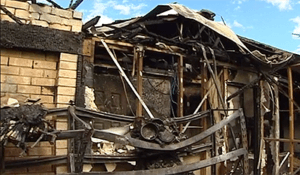
On 18 November 2011 an early morning fire at Quakers Hill Nursing Home killed 11 elderly residents, seriously injured others and caused the evacuation of up to 100 people. Three people died in the fire, and a further eight residents of the home died later in hospital from their injuries. The fire started in two places and was regarded by police as suspicious.
A nurse working in the home was later arrested and charged with four counts of murder.
Part of evacuation of residents, due to their high level of physical support and a need to exit the building quickly required staff to leave patients in their beds and wheel them out and away from the building. However, during investigations resident’s beds were found to be abandoned and scattered in corridors and along exit ramps at points requiring 90 degree turns. The coroner found that due to insufficient turning circulations to turn beds they were abandoned which resulted in patients being physically carried or dragged out of the building, a slow inconvenient and somewhat hazardous process.
Also, apart from the ramp design, Supt Jurgeit also believed that the evacuation had been hindered by roof debris falling into the corridors. It is noted that this building was not sprinkler protected.
In December 2011 Fire & Rescue NSW carried out tests at the CSIRO re-constructing various bedrooms within the wards. The rooms’ dimensions were the same as the original although the construction methods differed from the original. Furniture was also included in the rooms to match each ward on the day.
In the first test, one of the resident’s bedrooms were replicated, with ignition starting halfway along the north side bed. The fire developed slowly and gradually spread to the adjoining bed. The fire then gained momentum and developed into a fully involved fire. The maximum temperature reached during the 24 minutes duration was 1070° C.
An identical room was then test-burnt to demonstrate the difference a sprinkler system would have made. It was dramatic and would have been life-saving with the test sprinklers activating after four minutes. The fire was confined to the bed of origin with minor smoke and heat damage to the room. The maximum temperature reached was 92° C (Coroners.justice.nsw.gov.au, 2018).
Subsequently the fire led to changes in the NSW Planning and Environment Act where existing Aged care facilities were required to retrofit sprinkler systems within their buildings over an 18-month period. Again, this is a case where buildings at the time of construction may be deemed fit for purposes but not suitable over the buildings lifetime.
Legislation
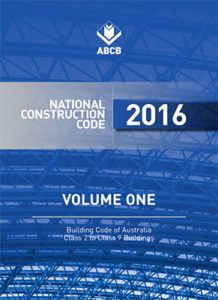
Typically, the people that SDA is intending to cater for have been managed by government organisations such as the Department of Health and Human Services which have their own fire safety design requirements that go over and above the BCA to enhance the safety of people who may not have the ability to recognise or evacuate in an efficient manner without assistance.
However, with the introduction of SDA the NDIA has changed the standard model of management and now provides the opportunity for both private and government organisation to build and operate accommodation for persons with disability. This change is not necessarily negative, there just needs to be appropriate avenues to ensure that the safety of residents is a priority.
The NDIA estimates that by 2019 the NDIS will cover 460,000 participants at a cost of $22 billion each year. The roll-out of the NDIS means that buildings previously constructed as dwellings for Class 1a usage (hereafter referenced as Class 1a buildings) will be proposed for accommodation as part of NDIS funded plans for disabled persons eligible for funding under the scheme. Putting aside the question of whether the use of these buildings can remain as Class 1a dwellings, as opposed to another classification. If these buildings were assessed under the DHHS Guidelines, sprinkler protection would need to be provided for buildings having at least one resident with a DHHS profile of Type 2 or greater. Many of these buildings would need to be retrofitted with sprinklers but the associated cost is substantial – it being much more economical to fit sprinkler protection to a new building rather than an existing one. Furthermore, financial resources are limited and there are many competing demands, for example some buildings will be leased, and owners may not wish to have sprinklers installed in their building, due to increased long-term maintenance costs and other factors. It is noted that there are allowances for fire sprinklers within the Specialist Disability Accommodation Price guide to offset installation/maintenance costs. It is noted that the costs associated with a change of use from an existing BCA Class 1a may be very substantial, irrespective of the BCA DtS fire-safety requirements. Given that life-threatening fire is known to be a relatively rare event, there is a tension between having an appropriate level of fire safety in existing buildings and sufficient funding to achieve the intended purpose of the NDIS – an increase in the wellbeing of disabled persons (Fpaa.com.au, 2018).
Building Classes
According to the guidelines published by the ABCB, Building Classification that may represent Specialist Disability Accommodation may be;
Class 1a building – A single dwelling being a detached house; or one of a group of attached dwellings being a town house, row house or the like.
Class 1b buildings – Are a boarding house, guest house or hostel that has a floor area less than 300 m2, and ordinarily has less than 12 people living in it. It can also be four or more single dwellings located on one allotment which are used for short-term holiday accommodation.
Class 3 buildings – Are residential buildings other than a Class 1 or Class 2 building. They are a common place of long term or transient living for a number of unrelated people. Examples include a boarding house, guest house, hostel or backpackers (that are larger than the limits for a Class 1b building). Class 3 buildings could also include dormitory style accommodation, or workers’ quarters for shearers or fruit pickers. Class 3 buildings may also be “care-type” facilities such as accommodation buildings for children, the elderly, or people with a disability, and which are not considered to be Class 9 buildings (ABCB, 2017).
Class 9a buildings – Are considered Health Care buildings whose patients are undergoing a form of medical treatment and may need physical assistance to evacuate in an emergency.
The BCA and the advisory note published by the ABCB mentions both Class 3 and 9a may be a ‘care type’ facility or accommodation for people with a disability where residants may need physical assistance to evacuate.
One of the difficulties is that building surveyors may feel limited in Classifying a building with a higher set of standards that may also fall within another ‘less stringent’ building class. Under the Victorian Building Act 1993, Section 24, Subject to section 24A and Division 4, ‘the relevant building surveyor must not issue a building permit that imposes on the applicant lesser or greater standards or requirements than those prescribed by this Act or the building regulations, unless permitted to do so by this Act or the building regulations’.
In Victoria, a building surveyor could potentially be held liable for even Classing a Class 1b boarding house as a Class 3 if the house falls under the parameters of a Class 1b building, even if its purpose is to house people with significant disabilities. When we verbally contacted the Victorian Building Authority for comment, they referred us to Section 24 of the Victorian Building Act 1993 and also mentioned they would be reluctant to over impose the requirements found within the Victorian Building Act 1993.
Recommendations
People with disability are amongst some of the most vulnerable people within our population, but to add to this, SDA is only intended to house people at the highest end of the spectrum, increasing the importance of life safety features.
It is our opinion that although the ‘purposes for which it is designed’ may fall within Class 1a or 1b, the reality is the characteristic of the occupants vs the minimum safety requirements of these Classes are not fit for purpose. Both have minimal life safety features, Class 1b’s are slightly more stringent with Smoke detectors being required within every bedroom as well as common areas.
Considering the criteria for SDA eligibility is persons with ‘Extreme Functional Impairment or Very High Support Needs’ it’s not unrealistic to suggest that occupants will not have the physical capacity and/or cognitive ability to act in a swift and efficient manner to evacuate the building without some form of assistance. Kew Cottages and Quaker Hills demonstrate a prime example where the level of fire safety compared to occupant needs fell short, both initiating changes in legislation but only after people lost their lives.
With the introduction of SDA housing and the push for domestic style dwellings, we believe the regulations are still catching up to define appropriate requirements around persons with extreme disabilities living in housing designed for domestic purposes, and this could have disastrous consequences. These types of dwellings should be viewed as falling between Class 3 accommodation with occupants whose needs closely resemble those of occupants of a Class 9a healthcare building.
Subsequently, as a minimum we believe that all SDA properties should also be protected with Fire Safety features resembling Class 3/9a buildings, this includes;
- Sprinklers protection throughout;
- Fire/smoke Compartmentation;
- Materials i.e. floor/wall/ceiling lining that meet appropriate Fire Hazard properties.
In the end practicality and logical thinking are the key, what is the purpose of the building and how will it function. The last thing anyone wants is to be standing in the Coroner’s Court explaining why their decision caused the death of building occupants.
References:
ABCB. (2017). Available at: http://www.abcb.gov.au/Resources/Publications/Education-Training/Building-classifications [Accessed 29 Jan. 2018].
Abs.gov.au. (2018). 4102.0 – Australian Social Trends, 2000. [online] Available at: http://www.abs.gov.au/Ausstats/abs@.nsf/2f762f95845417aeca25706c00834efa/1672d6d197020b08ca2570ec000e5353!OpenDocument [Accessed 28 Jan. 2018].
Courts.qld.gov.au. (2018). [online] Available at: http://www.courts.qld.gov.au/__data/assets/pdf_file/0004/86647/cif-childers-palace-hostel-fire-20060707.pdf [Accessed 25 Jan. 2018].
Coroners.justice.nsw.gov.au. (2018). [online] Available at: http://www.coroners.justice.nsw.gov.au/Documents/finding,%20recommendation%20and%20reasons%20-%20quakers%20hill%20fire.pdf [Accessed 28 Jan. 2018].
Fpaa.com.au. (2018). [online] Available at: http://www.fpaa.com.au/media/243693/fire_safety_and_the_ndis.pdf [Accessed 29 Jan. 2018].
Graeme Johnstone, Inquest Findings, Comments and Recommendations into Fire and Nine Deaths at Kew Residential Services on 8 April 1996. Melbourne, State Coroners Office, 1997, p. 10
NSW, F. (2018). Media release page. [online] Fire & Rescue NSW. Available at: https://www.fire.nsw.gov.au/news.php?news=2314 [Accessed 1 Mar. 2018].
Parliament.qld.gov.au. (2018). [online] Available at: http://www.parliament.qld.gov.au/documents/explore/ResearchPublications/ResearchBriefs/2002/2002001.pdf [Accessed 25 Jan. 2018].
Categories
Recent Posts
- Upgrading an Existing House to Specialist Disability Accommodation
- Why Robust SDA is Failing Participants, Carers and Investors
- You cannot certify Hybrid SDA with Robust and High Physical Support or Fully Accessible for the same dwelling
- Introducing the Turtle Tough TV enclosure—the perfect protection for your TV in Robust Specialist Disability Accommodation
- How much money will I earn investing in SDA Specialist Disability Accommodation?
